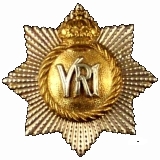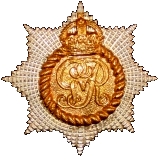
Recollections of a Nonagenarian
of Service in The Royal Canadian Regiment (1916-19)
Part 3
by Robert England, M.C.
JUNE 1917 TO THE SUMMER OF 1918
In June I was much involved in the preparations for the Avion Raid carried out by the 7th Brigade. The Royal Canadian Regiment, the 42nd Battalion and the 49th Battalion had launched a night attack June 7 on the German lines over 1,200 yards along the railway embankment into Lens in Vimy-Avion sector, penetrating 800 yards and in the hour and a half occupation destroying machine-gun posts and ammunition stores and dug-outs. My task was to keep contact for Lt. Col. Willets, set off return rockets and aid the returning raiders. The account given in the Fetherstonhaugh history covers the operation adequately, and rightly emphasizes the cool daring of Lieut. Gregg, recognized by the award of the Military Cross.
"Light duty" turned out to be orderly room work as courts' martial officer, clearing up a large back-log of cases, in its way a useful occupation giving me a chance to become familiar with K.R. & O. and Manual of Military Law.
The following morning, June 8, our guns were quiet and I watched the enemy under Red Cross flags carrying out dead and wounded. Soon I observed stretchers being borne "in" loaded, preceded by Red Cross flag wavers. So our guns were obliged to re-open shelling.
In July Lt. Col. C.H. Hill explained to me his dissatisfaction with the bombing capabilities of the Regiment, and asked me to undertake the duties of Bombing Officer, enlarge the number of specialists, and ensure that every combatant in the Battalion had had the opportunity to throw live bombs and fire rifle-grenades. The excellent Bombing Sergeant H. Brealey helped me to select a suitable number of trainees, whom we took to an isolated camp near Chateau de la Haie and here, under instructors, I and the trainees learned to respect and handle bombs.
At Lapugnoy in the rear area between July 26 and August 15, the R.C.R. had intensive training, particularly of sudden emergency and rapid assembly and our new bombing instructors Sgt. Brealey and I managed to give each man in the Battalion training in bomb-throwing and the firing of rifle-grenades.
On August 15, 1917 the Canadian Corps under the command of Sir Arthur Currie attacked and captured Hill 70 in the Lens Area. Four days later The Royal Canadian Regiment marched from Lapugnoy to Noeux les Mines and then to Les Brebis. Lt. Col. Hill then took me with him to visit the 22nd Battalion in its new captured trenches. We found Major George Vanier in command, and completed with him arrangements to relieve the "Van-doos" and 25th Battalion which the R.C.R. did on the evening of August 21, under shell-fire and threatened counter-attack. Sixteen were killed and 32 wounded. The trenches were a shambles, we had to bury some of the dead to get about. Supplies of bombs had to be brought forward to men under attack and every hour of my time was taken. In the early morning of the 23rd August 1917 I became a casualty—right shoulder and back gouged by shrapnel. With difficulty I was evacuated to an advance casualty clearing hospital at Noeux les Mines, very much within the artillery zone, where British Army doctors and nurses had saved many lives and managed to delay withdrawals of the unit ordered. A young surgeon operated on me promptly, cleaned out splinters of bone, and rearranged shoulder muscles to supply a missing muscle, sewed the long wound with 15 stitches. I was moved by barge on the canal from Bethune to Boulogne to the Duchess of Sutherland's hospital. My stitches were finally removed on September 6th, after two weeks of agony, on my arrival at the 3rd London General Hospital, Wandsworth. The picric acid and iodine used on the wound were hard on the skin.
I spent the winter of 1917-18 in hospital in physio-therapy and rehabilitation centres and in Matblock Bath convalescent hospital, reaching the 17th Reserve Battalion at Bramshott marked for light duty in the spring of 1918. "Light duty" turned out to be orderly room work as courts' martial officer, clearing up a large back-log of cases, in its way a useful occupation giving me a chance to become familiar with K.R. & O. and Manual of Military Law.
Meantime, the R.C.R. had not forgotten me. Lt. Col. Hill and his wife visited me in hospital. My special friend Steve Allan came on leave, stayed at the Junior Naval and Military Club, 96 Piccadilly. I helped Steve entertain the Robertson sisters of Montreal as their brother Hilary was a class-mate at McGill. The Fetherstonhaugh history quotes Lt. Col. Hill's kind remarks about my efforts at Hill 70. (I here may add that Major George Vanier (later Governor General) in the twenties sought me out at the CNR in London and remained a life-long friend, remembering our Hill 70 meeting.)
While still a patient in the 3rd London General, Lt. Col. C.R.E. Willets and his charming wife (daughter of the distinguished Professor McMechan of Dalhousie University) had Steve Allan and me to lunch at the Piccadilly, a very happy occasion for two young temporary subalterns. Steve and I went to a matinee of "Chu Chin Chow" at His Majesty's Theatre in Haymarket where the manager picked up our stall seats and with his compliments conducted us to the best box in the house. On leave or in hospital those were days when our minds welcomed the courtesies and kindnesses shown us, helping to redeem our spirits shaken by past experience and apprehension of what lay ahead.
- The O'Leary Collection; Medals of The Royal Canadian Regiment.
- Researching Canadian Soldiers of the First World War
- Researching The Royal Canadian Regiment
- The RCR in the First World War
- Badges of The RCR
- The Senior Subaltern
- The Minute Book (blog)
- Rogue Papers
- Tactical Primers
- The Regimental Library
- Battle Honours
- Perpetuation of the CEF
- A Miscellany
- Quotes
- The Frontenac Times
- Site Map

![]() The RCR in the Great War
The RCR in the Great War
![]() War Diary
War Diary
![]() Battle Honours
Battle Honours
![]() Battle Bars and The RCR
Battle Bars and The RCR
![]() The RCR Battle Bar Ledger (pdf)
The RCR Battle Bar Ledger (pdf)
![]() Honours and Awards
Honours and Awards
![]() Roll of Honour
Roll of Honour
![]() Prisoners of War
Prisoners of War
![]() Cemetery List
Cemetery List
![]() Cemetery Map
Cemetery Map
![]() Courts Martial
Courts Martial
![]() Officers
Officers
![]() RSMs of The RCR (1914-1919)
RSMs of The RCR (1914-1919)
![]() NCOs and Soldiers
NCOs and Soldiers
![]() An Officer's Diary (1914-1918)
An Officer's Diary (1914-1918)
![]() Recollections of a Nonagenerian (R. England) (1916-1919)
Recollections of a Nonagenerian (R. England) (1916-1919)
![]() On to Bermuda (1914-15)
On to Bermuda (1914-15)
![]() England and France 1915-1916 (Hayes; 1931)
England and France 1915-1916 (Hayes; 1931)
![]() Overseas with The Royals (1915)
Overseas with The Royals (1915)
![]() Regimental History Pamphlet (1917)
Regimental History Pamphlet (1917)
![]() Amiens (1918)
Amiens (1918)
![]() Cambrai (1918)
Cambrai (1918)
![]() Monchy-le-Preux (1918)
Monchy-le-Preux (1918)
![]() Under-aged Soldiers in The RCR
Under-aged Soldiers in The RCR
![]() Not All Were Volunteers; The RCR and the Military Service Act
Not All Were Volunteers; The RCR and the Military Service Act
![]() Sentenced to Death by Court Martial
Sentenced to Death by Court Martial
![]() The 7th Trench Mortar Battery
The 7th Trench Mortar Battery
![]() A Regimental Goat
A Regimental Goat
![]() Regiment and Family, Bermuda 1914-15
Regiment and Family, Bermuda 1914-15
![]() "March the Guilty Bastard In"
"March the Guilty Bastard In"
![]() Surrendered as Stowaway
Surrendered as Stowaway
![]() Re-Visiting the Great War Roll of Honour for The RCR
Re-Visiting the Great War Roll of Honour for The RCR
![]() Canadian Corps Trench Standing Orders (1916)
Canadian Corps Trench Standing Orders (1916)

